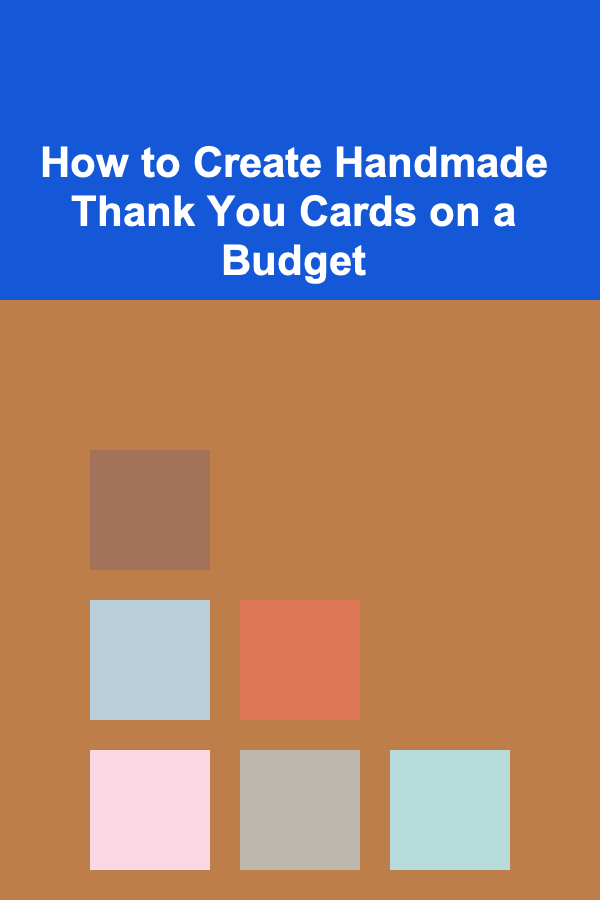
How to Create Handmade Thank You Cards on a Budget
ebook include PDF & Audio bundle (Micro Guide)
$12.99$11.99
Limited Time Offer! Order within the next:

Thank you cards are a simple yet powerful way to express gratitude, whether for a gift, a favor, or just for someone's kind presence in your life. While store-bought cards can be convenient, creating handmade thank you cards adds a personal touch that shows your effort and thoughtfulness. The good news is that you don't need a big budget or expensive supplies to create beautiful, handmade thank you cards. With some creativity and basic materials, you can craft charming cards that will leave a lasting impression.
This article will guide you through the process of creating handmade thank you cards on a budget, from choosing your materials to designing your card and adding that final personal touch.
Why Handmade Thank You Cards?
Handmade thank you cards offer several advantages over store-bought alternatives:
- Personalized: You can customize your card to suit the recipient's taste, making it a more meaningful expression of gratitude.
- Cost-effective: You can create beautiful cards with minimal expense, especially if you use recycled or repurposed materials.
- Creative expression: Designing your own cards allows you to explore your creativity and try new techniques in crafting.
- Sustainability: By using recycled paper or other eco-friendly materials, handmade cards can be a more environmentally conscious option.
Handmade cards are a heartfelt way to say thank you, and the process of making them can be just as enjoyable as giving them.
Basic Materials for Handmade Thank You Cards
You don't need a lot of expensive materials to create beautiful cards. In fact, some of the most stunning designs come from simple, budget-friendly supplies. Here's a list of basic materials you can use:
Paper and Cardstock
- Recycled paper: Old magazines, newspapers, or even scrap paper can be upcycled into beautiful card designs.
- Cardstock: Basic white or colored cardstock is inexpensive and provides a sturdy base for your cards.
- Colored paper: You can purchase inexpensive colored or textured paper to add extra flair to your cards.
- Old greeting cards: Repurpose old cards by cutting them up and using the images or designs on your new thank you cards.
Glue and Adhesives
- Glue sticks: These are affordable and perfect for adhering paper or other flat materials.
- Double-sided tape: A simple solution for attaching elements like embellishments or layered designs.
- Liquid glue: Good for precise application, especially if you're working with small elements.
Decorative Elements
- Stickers: Purchase inexpensive thank you stickers or embellishments from a craft store.
- Washi tape: This decorative tape is available in a variety of patterns and colors and can be used to frame your card or add a stylish border.
- Buttons, beads, and sequins: These items can add texture and interest to your card. Look for cheap packs that offer a variety of colors and sizes.
- Stamps: Rubber stamps with thank you messages or decorative designs can add a professional touch without the high cost of pre-made cards.
Markers and Pens
- Colored markers: Use these for writing messages, doodling, or adding borders.
- Gel pens: These pens come in a variety of colors and can create unique effects, such as metallic or glitter finishes.
- Calligraphy pens: If you want to add an elegant touch to your thank you card, a calligraphy pen is a great (and affordable) tool to use.
Other Tools
- Scissors: A simple pair of scissors is essential for cutting out shapes or trimming your cards.
- Paper cutter: If you plan on making a lot of cards, a paper cutter can speed up the process and give you clean, straight edges.
- Punches: Decorative punches can help you create fun shapes, such as hearts, stars, or flowers, to enhance your design.
Designing Your Thank You Card
The design of your thank you card will depend on the recipient, the occasion, and your personal style. Here are some design ideas to inspire you:
Simple and Elegant
A minimalistic design often feels sophisticated and personal. Here's how to achieve it on a budget:
- Monochrome color scheme: Choose one color or a pair of complementary colors for the background and lettering.
- Clean lines and simple shapes: Use a geometric design or a solid color with a thank you stamp or hand-lettered message.
- White space: Sometimes, less is more. Let the paper breathe by leaving open spaces around your message.
Layered and Textured
Layering different types of paper or adding texture can give your card a more dimensional look.
- Create a layered effect: Cut out shapes from colored paper and layer them on top of each other for visual interest.
- Use textured materials: Embossing folders or textured paper can add depth without the need for fancy embellishments.
- Add fabric accents: Recycled fabric scraps or lace can make your card look sophisticated without breaking the bank.
Fun and Whimsical
If you're making a thank you card for a friend or someone with a playful spirit, go for a lighthearted design:
- Use bright, bold colors: Incorporate vibrant colors to make the card stand out.
- Add quirky illustrations or doodles: You don't need to be an artist---simple sketches like hearts, flowers, or stars can work perfectly.
- Embellishments: Buttons, sequins, or washi tape can add fun, textural elements.
Eco-Friendly and Sustainable
If you're passionate about sustainability, create a thank you card using recycled materials:
- Upcycled materials: Use old maps, newspapers, or pages from books to create a unique design.
- Plantable cards: Consider creating a card with embedded wildflower seeds. The recipient can plant the card, making it a truly special and eco-friendly gesture.
- Natural materials: Incorporate elements like dried flowers, leaves, or twine to create a rustic, organic look.
Step-by-Step Guide to Making Your Thank You Card
Now that you have a sense of the materials and design ideas, here's a simple step-by-step guide to creating your own handmade thank you card.
Step 1: Prepare Your Materials
Gather all the materials you plan to use. If you're recycling old paper or cards, make sure they are cut into the right size and shape for your card.
Step 2: Cut and Fold Your Card
- Start with a piece of cardstock or recycled paper that is about 8.5 x 5.5 inches.
- Fold it in half to create a 4.25 x 5.5-inch card. Use a bone folder or the edge of a ruler to ensure a crisp fold.
- If you prefer, cut the paper to the size of your choosing, adjusting the size of the card to fit your design.
Step 3: Add Your Message
- Decide where you want to write your thank you message. The most common placement is the center of the card, but you can get creative and add it to the bottom, top, or off to the side.
- Use a pen, marker, or calligraphy tool to write a heartfelt message. Keep it simple and personal---expressing genuine thanks is the key.
- If you're not confident in your handwriting, consider using a rubber stamp or printed text.
Step 4: Decorate Your Card
- Add a decorative border, stamp, or doodle to enhance the design. You can also add embellishments such as buttons, sequins, or washi tape to give it texture.
- Layer pieces of colored paper, fabric, or other materials to create a dimensional look.
- If you're using recycled paper, consider cutting out a fun shape, like a flower or heart, and affixing it to the card for an added touch.
Step 5: Final Touches
- Review your card and make any final adjustments.
- If you want to give the card a little extra shine, consider adding a bit of glitter, or use a gel pen for accents and borders.
- Let the card dry completely before handling it to avoid smudging.
Ways to Save Money While Crafting Your Cards
Making handmade thank you cards doesn't need to be expensive. Here are some tips for crafting on a budget:
Buy in Bulk
Purchase basic supplies, such as cardstock, markers, and glue, in bulk. This will lower the cost per card and ensure you have plenty of materials for future projects.
Repurpose Old Materials
Recycle old cards, magazines, or newspapers. Use the images or text from these materials to create unique designs.
Shop Sales and Discounts
Look for sales at craft stores, especially during holiday seasons when discounts are often available. Consider using coupons or checking out online stores for cheaper prices on crafting supplies.
DIY Stamps
If you want to incorporate stamps but don't want to spend a lot of money, try making your own stamps using foam sheets, rubber, or even potatoes. This is an affordable way to get custom designs for your cards.
Conclusion
Creating handmade thank you cards on a budget is not only affordable but also a wonderful way to express gratitude. By using simple, inexpensive materials, you can create unique and heartfelt cards that will leave a lasting impression. Whether you're crafting for a friend, family member, or coworker, your effort and thoughtfulness will be appreciated. With a little creativity, you can transform even the most basic supplies into beautiful and meaningful works of art.
Reading More From Our Other Websites
- [Home Budget 101] How to Manage a Variable Income: Budgeting Tips for Freelancers and Gig Workers
- [Home Party Planning 101] How to Host an Unforgettable New Year's Eve Party with Creative Ideas
- [Personal Investment 101] How to Evaluate Real Estate Markets for Investment Opportunities
- [Personal Finance Management 101] How to Invest in Stocks as a Beginner
- [Toy Making Tip 101] Showcase Your Creations: How to Share and Monetize Your Toy-Making Passion Online
- [Personal Finance Management 101] How to Automate Your Savings for Consistent Growth
- [Organization Tip 101] How to Organize Your Pet's Schedule and Supplies
- [Home Staging 101] How to Stage Outdoor Spaces to Create a Cozy, Inviting Atmosphere
- [Organization Tip 101] How to Use Drawer Dividers for Customized Storage
- [Home Holiday Decoration 101] How to Decorate Your Home with Natural Elements for a Rustic Holiday Look

How to Create a Welcoming Atmosphere with Scent in Your Entryway
Read More
How to Design a Cozy Reading Nook in Your Study Room
Read More
What Tips Can You Use to Deal With Clutter After Moving?
Read More
How to Sew a Simple Zipper Pouch
Read More
10 Tips for Scratch-Building Model Cars from Kits
Read More
10 Tips for Staying Motivated with Your Investing To-Do List
Read MoreOther Products

How to Create a Welcoming Atmosphere with Scent in Your Entryway
Read More
How to Design a Cozy Reading Nook in Your Study Room
Read More
What Tips Can You Use to Deal With Clutter After Moving?
Read More
How to Sew a Simple Zipper Pouch
Read More
10 Tips for Scratch-Building Model Cars from Kits
Read More